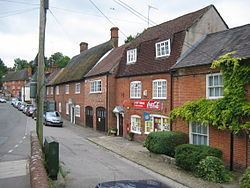Population 1,622 (in 2011) Civil parish Potterne Local time Saturday 8:57 AM | OS grid reference ST995584 | |
 | ||
Weather 7°C, Wind NE at 21 km/h, 75% Humidity | ||
Father of three year old saves the mill preparatory school from closing potterne wiltshire
Potterne is a village and civil parish in the county of Wiltshire, England. The civil parish includes the hamlet of Potterne Wick. It is 2 miles (3.2 km) south of Devizes and lies on the A360 which links Devizes to Salisbury. Potterne is known as 'The Place of Springs' since there are many springs around the village; this title was used by the former primary school (Potterne CEVC Primary School) on its emblem.
Contents
- Father of three year old saves the mill preparatory school from closing potterne wiltshire
- Map of Potterne Devizes UK
- Local government and services
- Church
- Notable buildings
- Amenities
- The Potterne Mummers
- Blounts Court
- Notable people
- References
Map of Potterne, Devizes, UK
Local government and services
The civil parish elects a parish council. It is in the area of Wiltshire Council unitary authority, which is responsible for all significant local government functions.
The headquarters of Wiltshire Fire and Rescue Service are on the outskirts of the village.
Church
The Anglican Church of St Mary is Grade I listed. Dating from the 13th century with restoration in 1872 by Ewan Christian, it is described as "pure Early English".
Notable buildings
Amenities
The village has a post office, village hall, village shop, youth club, playing field and a park.
There is one pub, the George & Dragon.
There is a preschool and a primary school (Five Lanes CE VC Primary School) which has two sites: for younger children at Potterne and for older children in the nearby village of Worton.
Potterne Cricket Club, founded as part of the village sports team in 1936, play in the West of England Premier League and Wiltshire County Cricket League.
Many residents of Potterne are part of the 'Potterne Panto Group' which present pantomimes nearly every February. Recently, the village has held Christmas markets in December which have attracted many visitors.
The village has several farms, with many residents working in agriculture, either within the parish or beyond. There are many other small businesses operating in the village such as interior designers, household crafts, landscaping and tourist accommodation.
The Potterne Mummers
The village is home to the Potterne Mummers, who re-enact performances of a traditional Mummers play during the week before Christmas in pubs around the Devizes area and ending each year with a performance at the George and Dragon, Potterne, on Christmas Eve. The Mummers were founded in 1953 by Bernard Baker, a local schoolteacher, who brought together a group to perform a local Mummer's Play which he had found from an archive report from the late nineteenth century. The initial revival of the play only lasted one year; it was performed by Potterne teenagers under the direction of Bernard Baker. In 1976 the cast included Nigel Weeks as Valiant Soldier, and it was next performed in 1972, with a cast which included Mick Hiscock. It has been performed every year since and is a firm annual tradition and the cast, still including Mick Hiscock, put on their tatter coats and tour the pubs collecting money for various charities including the Wiltshire Air Ambulance.
The Potterne Mummers were presented to Prince Philip in 2012 at the Queen's Jubilee event at Salisbury Cathedral and were shortlisted for a Community Service award in 2014. The current group members, as of 2016, include Brian German, John Chandler, Bob Berry, Karel Bechler, Dan Hiscock, Mick Hiscock, pete Taylor, Bill Hicks, Eric Partridge and Andy Gover.
Blount's Court
A medieval part of what is now Potterne was the manor of Blount's Court, which probably originated in the 13th century. By 1953, the house and property now known as Blount's Court had been owned by the Stancomb family since 1809, when William Stancomb started building the house, for which he revived the ancient name. His son William died in 1941 at the age of 90. Blount's Court, which is now divided into flats, is a large 19th Century 'gothic' building with a porch carried up as a battlemented tower. The centre block is of three stories, the wings are of two. The windows are squareheaded, mullioned, and transomed, the parapets battlemented. Blount's Court is also the name given to the suburban public street, of about 100 houses, leading up to the private property surrounding the block of flats.
